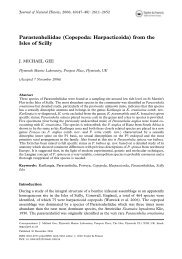An Updated Classification of the Recent Crustacea
An Updated Classification of the Recent Crustacea
An Updated Classification of the Recent Crustacea
Create successful ePaper yourself
Turn your PDF publications into a flip-book with our unique Google optimized e-Paper software.
Bousfield, E. L. 1996. A contribution to <strong>the</strong> reclassification<br />
<strong>of</strong> neotropical freshwater hyalellid amphipods<br />
(<strong>Crustacea</strong>: Gammaridea: Talitroidea). Bull. Mus.<br />
civ. St. nat. Verona 20[1993 (1996)]:175–224.<br />
Submitted by Ed Bousfield,<br />
Ottawa, Canada<br />
AMPHIPODA: GAMMARIDEA<br />
There would seem to be a second main reason why<br />
you might regret not employing a natural (superfamily)<br />
classification <strong>of</strong> <strong>the</strong> Gammaridea. Not only<br />
<strong>the</strong> Lysianassoidea, Talitroidea and Corophioidea,<br />
but about 75% <strong>of</strong> superfamilies <strong>of</strong> <strong>the</strong> Bousfield–<br />
Schram phyletic classification (including Jerry Barnard’s<br />
anglicized versions) are variously utilized by<br />
major workers today—if only because <strong>the</strong>y make<br />
pragmatic (workable) sense.<br />
Interestingly, and to my knowledge, none <strong>of</strong><br />
those who apparently condemn <strong>the</strong> present superfamily<br />
categories because <strong>the</strong>y ‘‘have not been derived<br />
cladistically’’ has attempted a natural treatment<br />
<strong>of</strong> all 113 families (embracing 5000 species!)<br />
<strong>of</strong> your list, based on cladistics alone.<br />
Why?—not only is <strong>the</strong> task extremely difficult and<br />
time-consuming, but <strong>the</strong> feasibility <strong>of</strong> obtaining a<br />
single, credible, ‘‘all-inclusive’’ answer with that<br />
methodology alone is highly improbable, and I<br />
think <strong>the</strong>y know it! On <strong>the</strong> o<strong>the</strong>r hand, rDNA studies<br />
seem virtually unaffected by homoplasious convergence<br />
<strong>of</strong> morphological character states ‘‘across<br />
<strong>the</strong> board’’ and are quite promising—if only someone<br />
would get started!<br />
The second, and perhaps more important, essentially<br />
scientific reason is that gammarideans, virtually<br />
alone among crustacean higher taxa (including<br />
<strong>the</strong> 3 o<strong>the</strong>r amphipod suborders!) would remain<br />
unclassified phyletically. Such an anomalous situation<br />
will be corrected inevitably—hopefully sooner<br />
than later—providing <strong>the</strong> principal reason for phyletic<br />
classification in <strong>the</strong> forthcoming CNAI lists<br />
and Pacific amphipod guide. Sars, Stebbing, and<br />
o<strong>the</strong>r perceptive ‘‘turn-<strong>of</strong>-<strong>the</strong>-century’’ amphipodologists<br />
might <strong>the</strong>n cease ‘‘rolling over in <strong>the</strong>ir<br />
graves’’!<br />
Submitted by Ed Bousfield,<br />
Ottawa, Canada<br />
ISOPODA<br />
In <strong>the</strong> near future, we must abandon <strong>the</strong> use <strong>of</strong><br />
Linnean categories, because we are currently identifying<br />
many more encaptic levels <strong>of</strong> monophyletic<br />
groups than <strong>the</strong>re are hierarchical levels in <strong>the</strong> Linnean<br />
system. The Paranthuridae, for example, are<br />
definitely a monophyletic group that contains fur<strong>the</strong>r<br />
subgroups. To erect new families for <strong>the</strong>se subgroups<br />
means to give up a categorical rank for <strong>the</strong><br />
taxon Paranthuridae.<br />
The same problem exists for <strong>the</strong> Epicaridea. New<br />
molecular evidence (Ph.D. <strong>the</strong>sis <strong>of</strong> H. Dreyer)<br />
proves that <strong>the</strong>se parasites <strong>of</strong> crustaceans are derived<br />
from a common ancestor shared with <strong>the</strong> Cymothoidae<br />
(fish parasites). Thus, <strong>the</strong> suborder Epicaridea<br />
is placed within <strong>the</strong> suborder ‘‘Flabellifera’’<br />
or, more precisely, within <strong>the</strong> suborder Cymothoidea<br />
sensu Wägele (1989), <strong>the</strong> sister group <strong>of</strong> <strong>the</strong><br />
suborder being a taxon classified as a family.<br />
Concerning <strong>the</strong> hypo<strong>the</strong>sis that <strong>the</strong> Sphaeromatidae,<br />
Serolidae, and o<strong>the</strong>r groups are derived from<br />
a disc-shaped ancestor (<strong>the</strong> ancestor <strong>of</strong> <strong>the</strong> Sphaeromatidea<br />
sensu Wägele, 1989), new evidence was<br />
discovered with <strong>the</strong> fossil Schweglerella stroebli<br />
(Polz, H. 1998. Archaeopteryx 16:19–28). This animal<br />
shows nei<strong>the</strong>r <strong>the</strong> apomorphies <strong>of</strong> <strong>the</strong> Serolidae<br />
nor <strong>of</strong> <strong>the</strong> Sphaeromatidae or o<strong>the</strong>r related extant<br />
taxa, but shows those characters identified as<br />
apomorphies <strong>of</strong> <strong>the</strong> suborder Sphaeromatidea (e.g.,<br />
disc-shaped body, head immersed in first pereonite,<br />
dorsal eyes).<br />
The subdivision <strong>of</strong> <strong>the</strong> Oniscidea into Tylomorpha<br />
and Ligiamorpha does not reflect <strong>the</strong> phylogeny<br />
<strong>of</strong> terrestrial isopods, as shown by Erhard<br />
(1996, 1998). Detailed phylogenetic analyses based<br />
on morphological characters will be published soon<br />
(Ph.D. <strong>the</strong>ses <strong>of</strong> C. Schmidt and <strong>of</strong> A. Leistikow).<br />
Submitted by J. W. Wägele,<br />
Ruhr-Universität Bochum, Germany<br />
SYNCARIDA<br />
The author <strong>of</strong> both <strong>the</strong> Bathynellidae and Bathynellacea<br />
is Chappuis, 1915. I have copied <strong>the</strong> paper<br />
by Chappuis (1915) for you. I am a bit surprised<br />
that you cite Lopretto and Morrone (1998) who<br />
have added nothing new to our understanding <strong>of</strong><br />
Syncarida. You should quote those who have.<br />
Submitted by H. Kurt Schminke,<br />
Universität Oldenburg, Germany<br />
DECAPODA: CARIDEA<br />
I am puzzled to find <strong>the</strong> family Barbouridae among<br />
<strong>the</strong> superfamily Bresilioidea. Chace (1997) put<br />
<strong>the</strong>m among <strong>the</strong> hippolytids. Christ<strong>of</strong>fersen (1987,<br />
1990) put <strong>the</strong>m in <strong>the</strong> superfamily Crangonoidea.<br />
Who put <strong>the</strong>m among <strong>the</strong> bresilioideans, and why?<br />
This is not stated clearly in your section on <strong>the</strong> superfamily<br />
Bresilioidea on p. 61. [Editor’s note: <strong>the</strong><br />
family Barbouriidae Christ<strong>of</strong>fersen was mistakenly<br />
placed by us in <strong>the</strong> Bresilioidea; this has since been<br />
corrected and <strong>the</strong>y are now listed among <strong>the</strong> Alpheoidea.]<br />
O<strong>the</strong>rwise, <strong>the</strong> classification contains <strong>the</strong> usual<br />
fights between lumpers and splitters. I think that<br />
Christ<strong>of</strong>fersen’s classification may fall apart in <strong>the</strong><br />
future because much <strong>of</strong> it is based on descriptions<br />
from <strong>the</strong> literature and not on examination <strong>of</strong> actual<br />
specimens. Some <strong>of</strong> <strong>the</strong> descriptions are inaccurate<br />
or do not contain pertinent information<br />
needed in classification today.<br />
Submitted by Mary K. Wicksten,<br />
Texas A&M University<br />
Contributions in Science, Number 39 Appendix I: Comments and Opinions 109











